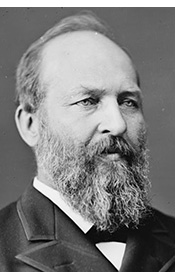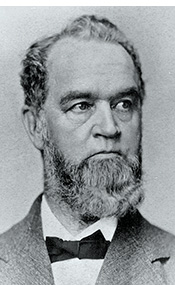(This article originally was published in the April 2016 issue of Christian Standard. We are sharing it again, five years later, on the occasion of our 155th anniversary.)
By Richard Cherok
For a century and a half, CHRISTIAN STANDARD has both informed and influenced the Stone-Campbell Movement. From its first edition on April 7, 1866, which featured news of Alexander Campbell’s death, through this sesquicentennial issue (and forward from here!), CHRISTIAN STANDARD has offered articles, interviews, editorials, reviews, and news of relevance to both the Restoration Movement and the larger Christian community.
Since its inception, CHRISTIAN STANDARD has endured shifting theological trends, controversies, two major divisions within the movement, changing editorial and publication policies, alterations in the paper’s formatting, sales of the parent company, and an ever-fluctuating sociocultural environment. Yet, the magazine’s purpose statement, which first appeared on the masthead of the January 2, 1869, issue, remains the same: “Devoted to the restoration of New Testament Christianity, its doctrines, its ordinances, and its fruits.”
Strong Backing
Plans for the publication originated in an assembly of 14 men on December 22, 1865, in the home of millionaire oilman Thomas W. Phillips Sr. of New Castle, Pennsylvania. Among the notable participants in this gathering were W.K. Pendleton, a son-in-law and longtime coworker with Alexander Campbell; James A. Garfield, a U.S. congressman and future president; and Isaac Errett, a noted educator and minister among Restoration Movement churches. Desiring to promote the principles of New Testament Christianity, as espoused by the “nineteenth-century reformation,” the group proposed the formation of a joint-stock company and a weekly magazine that would be headquartered in Cleveland, Ohio. Additional meetings over the next few weeks identified their company as the “Christian Publication Association,” established a board of directors, elected Errett as the journal’s editor, and named the magazine CHRISTIAN STANDARD.

With strong financial backing and a solid leadership corps, the founders of CHRISTIAN STANDARD expected the paper to gain rapid success and bring a quick return on their investments. The looming death of Alexander Campbell, they believed, would leave a leadership vacuum in the expanding movement that CHRISTIAN STANDARD could satisfy. Moreover, the new national era, ushered in by the recent end of the Civil War, called for a fresh publication that would appeal to a new audience.
As the company’s organizers soon discovered, however, the lingering sectional conflicts associated with the Civil War survived the conflict, and CHRISTIAN STANDARD was quickly labeled a Northern paper. Southerners, who remembered Errett’s wartime sympathy for the Union, were less than amenable to his tolerance for innovations, specifically instrumental music in the churches and missionary societies, and opted to read the Gospel Advocate rather than CHRISTIAN STANDARD. Thus the readership and investment returns the founders expected were not quickly to be realized.
By early January 1868, CHRISTIAN STANDARD’s failure to achieve profitability led the directors of the Christian Publication Association to dissolve their company and grant Errett both ownership and full control of the fledgling magazine. Determined to make CHRISTIAN STANDARD viable, Errett moved the paper to Alliance, Ohio, where he had accepted an invitation to become president of newly formed Alliance College. Amid his extensive efforts to sustain the journal, Errett continued to lose money, and CHRISTIAN STANDARD’s future appeared to be in doubt.
The turning point for the paper’s survival came in the summer of 1869, when R.W. Carroll, a successful Quaker publisher, agreed to underwrite the publication if Errett would relocate to Cincinnati. In their arrangement, Errett maintained editorial control of CHRISTIAN STANDARD and Carroll took control of its business affairs. The partnership was exceptionally successful, doubling the readership of CHRISTIAN STANDARD by 1871 and prompting the formation of the Standard Publishing Company in 1872. When Carroll decided to divest himself of the company in 1874, Errett purchased his shares of the corporation and gained sole ownership of the Standard Publishing Company.
Supporting Evangelism
As editor, Errett established himself as a passionate supporter of world evangelism. Through numerous editorials, Errett expressed his concerns for advancing the Christian cause and called for the formation of a society that would devote itself to sending missionaries throughout the world. In 1874, as Caroline Neville Pearre and others worked to create the Christian Woman’s Board of Missions, Errett championed their cause with an editorial entitled “Help Those Women.”
One year later, Errett participated in the creation of the Foreign Christian Missionary Society. He went on to become the FCMS’s first president and held the position for the remainder of his life. Through his efforts as the editor of CHRISTIAN STANDARD and as a prominent Christian leader, Errett increased both missionary support and interest within the Stone-Campbell Movement.
Errett controlled the editorial chair until his death in 1888. During his tenure, Errett was thoroughly dedicated to the Restoration plea and charted a course for the paper that was biblically conservative without straying into the realm of legalism.
His son, Russell Errett, who managed the company and oversaw the direction of CHRISTIAN STANDARD after his father’s death, was equally dedicated to the principles of the Restoration Movement. Though Russell did not take on the editorial duties of CHRISTIAN STANDARD, he exercised a strong influence over it and maintained his father’s vision for the paper until his death in 1931.
Resisting Liberalism
The years surrounding the onset of the 20th century introduced new perspectives on Christianity that Russell Errett deemed threatening to the principles of the movement. A trend toward theological modernism and the advent of “open membership” persuaded him to devote the resources of CHRISTIAN STANDARD—the movement’s largest publication at the start of the century—to the destruction of the insurgent ideas.
To combat the encroachments of liberalism, CHRISTIAN STANDARD ran a regular column, entitled “Biblical Criticism,” by conservative scholar J.W. McGarvey. In the popular essays, published from 1893 to 1904, McGarvey railed against the hermeneutical theories of higher criticism and defended the traditional perspectives on biblical revelation that marked the movement from its beginning.
CHRISTIAN STANDARD’s struggle with liberalism continued throughout the early decades of the 20th century. When the College of the Bible, a conservative ministry-training school in Lexington, Kentucky, hired avowed modernist A.W. Fortune to the faculty in 1912 (only one year after the death of McGarvey, who had been the school’s president), CHRISTIAN STANDARD ran a series of articles by evangelist John T. Brown exposing Fortune’s liberal leanings.
In 1917, after more modernists were added to the school’s faculty, CHRISTIAN STANDARD published a letter from a group of students who accused the college of promoting “destructive criticism.” CHRISTIAN STANDARD’s promotion of the incidents in Lexington, as corroborated by Hall L. Calhoun, McGarvey’s conservative protege who resigned as the school’s dean to protest the liberal takeover, ultimately led to the emergence of the Bible college movement for preparing ministers to serve in the conservative churches.
In 1919, just two years after the commotion surrounding the College of the Bible, CHRISTIAN STANDARD publicized the Christian Woman’s Board of Missions’ abandonment of E.T. Westrup’s work in Monterrey, Mexico. By entering into a comity agreement with the missionary organizations of the Methodists and Presbyterians, the CWBM turned northern Mexico over to the Methodists and instructed Westrup to relocate to the central region of the country. In an effort to preserve Westrup’s work, CHRISTIAN STANDARD called for financial support to keep the mission alive. Though a number of direct-support missionaries (missionaries who operated without the backing of an organization) had existed prior to CHRISTIAN STANDARD’s support for Westrup, the Monterrey situation essentially opened the door for the growth of an independent missionary enterprise.
At the same time, plans were underway to merge the movement’s agencies into one large organization known as the United Christian Missionary Society. Not only would the UCMS become the arbiter of missionary funding, it was viewed by conservatives as an overarching entity with little accountability to the churches. And, as open membership came to light on the mission field, specifically in the China Mission, CHRISTIAN STANDARD reported the news that the UCMS seemed to ignore.
By 1926, the controversy surrounding the UCMS’s toleration of comity agreements and open membership reached its climax at the International Convention of Disciples of Christ in Memphis, Tennessee. Convinced their concerns were being disregarded by the liberal leadership of the convention, conservatives made plans for the formation of a separate convention to be held the following year in Indianapolis, Indiana. With backing and promotion from CHRISTIAN STANDARD, the North American Christian Convention was born in 1927.
Rallying Conservatives
The conservative-liberal fissure set in motion at the Memphis convention grew deeper and wider in the decades that followed. During this time, CHRISTIAN STANDARD functioned as both the voice of the conservatives and a cohesive rallying point for the independent churches. When the liberals authorized the Commission on Restructure to reorganize the church along denominational patterns, CHRISTIAN STANDARD vehemently opposed the plan. Once the plan for Restructure gained acceptance at the 1968 International Convention, creating the Christian Church (Disciples of Christ) denomination, many conservatives withdrew their churches from affiliation with the Disciples.
During roughly the same time frame, CHRISTIAN STANDARD noted candidates for military chaplaincy within the movement required approval from the liberal leadership of the International Convention. This prompted an effort to create the Chaplaincy Endorsement Commission of Christian Churches and Churches of Christ to sanction chaplaincy candidates from the conservative churches. The Armed Forces Chaplains Board approved the Chaplaincy Endorsement Commission for the independent churches in 1969. The Chaplaincy Endorsement Commission also requested a separate listing for Christian churches/churches of Christ in the Year Book of American Churches, which was granted in 1971, thus formalizing the separation of the Disciples of Christ and Christian churches/churches of Christ.
After 150 years, CHRISTIAN STANDARD’s influence in the Stone-Campbell Movement remains significant. As a leading voice among the Christian churches/churches of Christ, the publication continues to both uphold their causes and concerns, and to function as a cohesive entity amid a fellowship of churches having no centralized denominational headquarters. Not only did CHRISTIAN STANDARD influence the development of the North American Christian Convention and many of the schools associated with the Christian churches/churches of Christ, it has also promoted them throughout the decades. CHRISTIAN STANDARD has also publicized church events, ministerial undertakings, camps and conferences, and numerous other activities associated with the Christian churches/churches of Christ.
Though the times have changed and the magazine has adapted to these changes, CHRISTIAN STANDARD persists as a valuable tool for a movement “devoted to the restoration of New Testament Christianity, its doctrines, its ordinances, and its fruits.”
When he wrote this article, Richard Cherok was professor of church history at Cincinnati (Ohio) Christian University. Today he serves as professor of church history and U.S. history with Ozark Christian College, Joplin, Mo.



0 Comments